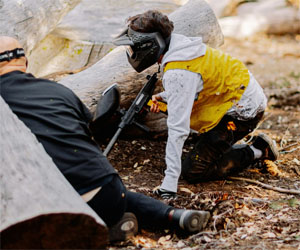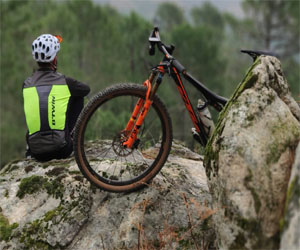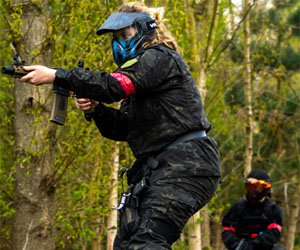


Strategies For Success

In the exhilarating world of paintball, where strategy meets adrenaline, challenge tactics play a pivotal role in determining the outcome of the game. Paintball is not just a recreational pursuit; it's an intricate dance of wits, teamwork, and individual skill, all woven together on a canvas of adventure. In this article, we'll explore the art of paintball challenge tactics and how they can help you overcome obstacles and secure victory on the battlefield.
The Role Of Challenge Tactics In Paintball
Challenge tactics in paintball involve tackling specific scenarios or obstacles that can impede your team's progress. These challenges can range from breaking through enemy lines to capturing a flag or defending a critical position. Mastering these tactics is essential for success in paintball, as they can turn the tide of the game in your favor.
Key Challenge Tactics In Paintball
Flag Capture And Defense: Many paintball games involve capturing flags or other objectives. To excel in this challenge, designate a team member or a group to capture the flag, while others provide cover and defend the area. Communication and coordination are vital to ensure the flag reaches its destination.
Obstacle Negotiation: Paintball fields are typically filled with various obstacles and structures. Knowing how to navigate these obstacles effectively, whether by using them as cover or as a vantage point, is crucial for success.
Suppressive Fire: When faced with a challenge, laying down suppressive fire can keep your opponents at bay. This tactic allows your team to move, reload, or change positions while restricting the movement of the opposing team.
Crisis Management: Sometimes, unforeseen challenges arise during a game, such as a key player being eliminated or a sudden change in the game's objective. Being able to adapt and manage such crises is an essential paintball skill.
Distraction And Feint: Employ diversion tactics to distract the enemy and lead them away from critical areas. By creating diversions, you can maneuver your team or carry out other objectives without immediate opposition.
Defensive Strongholds: When facing a challenge to hold a position, creating defensive strongholds is vital. Construct barricades or utilize natural cover to fortify your position and withstand enemy attacks.
Infiltration And Ambush: When a challenge involves infiltrating enemy lines, stealth and ambush tactics can be effective. Move quietly, avoid detection, and catch your opponents off guard.
Flag Extraction: In scenarios where you need to extract a flag or objective from the enemy's territory, devise a plan to retrieve it safely. This may involve distraction, cover fire, and swift movement.
Mastering Paintball Challenge Tactics
To excel in paintball challenge tactics, practice and teamwork are essential. Regularly engage in paintball matches to hone your skills and adapt to different scenarios. Communication with your team is key, as it ensures everyone is on the same page and working together to tackle challenges.
Ultimately, the art of paintball challenge tactics is about adapting and overcoming obstacles. Whether it's capturing flags, navigating obstacles, or dealing with unexpected crises, mastering these tactics will elevate your paintball game and bring you success in the heart-pounding realm where strategy and adrenaline collide.
A Journey Of Adventure And Discovery
 Unforgettable mountain biking memories often stem from the pursuit of new challenges. For experienced riders, it might mean pushing their limits on steeper descents or tackling more technical trails. For beginners, it could be the first successful climb up a steep hill or navigating a rocky section without a mishap. These challenges, when overcome, leave riders with a profound sense of achievement and memories that are forever etched in their minds.
Unforgettable mountain biking memories often stem from the pursuit of new challenges. For experienced riders, it might mean pushing their limits on steeper descents or tackling more technical trails. For beginners, it could be the first successful climb up a steep hill or navigating a rocky section without a mishap. These challenges, when overcome, leave riders with a profound sense of achievement and memories that are forever etched in their minds.
Mountain biking also offers a unique opportunity to forge deep connections with the natural world. It takes riders to remote and pristine locations where they can immerse themselves in the tranquility of the great outdoors. The sounds of rustling leaves, the scent of pine trees, and the sights of breathtaking landscapes are all part of the sensory experience that creates lasting memories.
Moreover, mountain biking often becomes a communal activity, where friends and fellow riders come together to share the thrill of the ride. The camaraderie, laughter, and shared experiences further enhance the memories created on the trails. Many riders look back on group rides with fondness, reminiscing about the times they conquered challenging trails and the friendships they formed along the way.


 The act of camping invites us to unplug from the digital world and embrace the solace of simplicity. With limited or no internet access, we are freed from the shackles of screens and notifications. Instead, we find ourselves engrossed in the here and now, appreciating the quietude of nature and the presence of loved ones around the campfire.
The act of camping invites us to unplug from the digital world and embrace the solace of simplicity. With limited or no internet access, we are freed from the shackles of screens and notifications. Instead, we find ourselves engrossed in the here and now, appreciating the quietude of nature and the presence of loved ones around the campfire.
Moreover, tranquil camping escapes allow us to reconnect with our most primal instincts. As we set up camp, gather firewood, and cook our meals over an open flame, we become attuned to the rhythms of the environment and the resources it provides. This connection with the essentials of survival fosters a sense of self-sufficiency and a deeper appreciation for the world around us.
Tranquil camping escapes are also an invitation to rediscover the beauty of simplicity. With fewer distractions and a pared-down lifestyle, we find ourselves rejoicing in the little things—a breathtaking sunrise, the soothing crackle of a campfire, or the wonder of stargazing without light pollution. These small moments of beauty are amplified in the peaceful backdrop of the natural world.
Furthermore, the allure of tranquil camping escapes lies in the bond it creates with friends and family.
Identifying Birds In The Wild
 Field Marks: Bird identification often begins with field marks, which are distinctive physical characteristics. These may include a bird's size, shape, coloration, markings, beak shape, and the pattern of its wings and tail. For example, the size and shape of a bird can help you distinguish a robin from a sparrow.
Field Marks: Bird identification often begins with field marks, which are distinctive physical characteristics. These may include a bird's size, shape, coloration, markings, beak shape, and the pattern of its wings and tail. For example, the size and shape of a bird can help you distinguish a robin from a sparrow.
Plumage And Colors: Observing a bird's plumage, or feathers, is a key aspect of identification. Look for unique color patterns on a bird's head, back, wings, and underparts. These colorations can vary widely among species, such as the vibrant red of a cardinal or the iridescent blue of a jay.
Behavior And Habitat: The behavior and habitat of a bird can provide valuable clues for identification. Some species are known for their distinctive behaviors, such as the woodpecker's habit of tapping on trees. Birds are also often associated with specific types of environments, like wetlands, forests, or grasslands.
Tools For Bird Identification:
Binoculars: A good pair of binoculars is essential for getting a closer look at birds in the wild. They allow you to discern fine details and field marks that might be indistinct to the naked eye.
Field Guides: Field guides are books or digital resources that provide detailed information on bird species. They contain illustrations, photographs, range maps, and descriptions that can help you identify birds based on their physical characteristics and habitat.
Apps And Websites: In the digital age, there are numerous bird identification apps and websites that offer comprehensive databases, bird calls, and interactive tools to assist in recognizing and learning about different bird species.
Audio Guides: Bird vocalizations, such as songs and calls, are crucial for bird identification. Audio guides or smartphone apps that provide bird sounds can be indispensable in determining the species you're observing.
A Game-Changer On The Field
 The Importance Of Precision Shots In Paintball
The Importance Of Precision Shots In Paintball
Precision shots in paintball are all about hitting your target with accuracy and effectiveness. These shots are more than just an impressive display of marksmanship; they are a fundamental aspect of the game that can have a significant impact for several reasons:
1. Conservation Of Resources: Paintballs are a finite resource, and running out of ammunition can leave you vulnerable. Making each shot count through precision shooting not only eliminates opponents but also helps conserve your paintballs for crucial moments.
2. Elimination Of Opponents: The primary objective in paintball is to eliminate opponents. Precision shots increase your chances of hitting your target, ensuring that they are eliminated from the game. Fewer opponents mean a better chance of securing victory.
3. Gaining Strategic Advantage: Precision shots can create strategic advantages by eliminating key players on the opposing team. When you take out the enemy's sharpshooters or players responsible for carrying objectives, it disrupts their plans and can lead to opportunities for your team.
4. Staying Concealed: When you hit your target with precision, they are less likely to know your exact location. This allows you to remain concealed and plan your next moves without giving away your position.
5. Winning Firefights: In one-on-one or small group firefights, precision shots can be the deciding factor. Hitting your opponent accurately gives you a significant edge in these encounters.
6. Boosting Confidence: Successfully executing precision shots boosts your confidence and morale. It enhances your perception of your own skills and encourages you to take calculated risks and make bold moves on the field.
Pickleball Court Dynamics
 The Non-Volley Zone: Also known as "the kitchen," this is a crucial area on the court that extends 7 feet from the net on each side. The kitchen is a no-volley zone, meaning that players cannot hit the ball out of the air within this zone. This rule encourages strategic play, as players must carefully position themselves to avoid faulting.
The Non-Volley Zone: Also known as "the kitchen," this is a crucial area on the court that extends 7 feet from the net on each side. The kitchen is a no-volley zone, meaning that players cannot hit the ball out of the air within this zone. This rule encourages strategic play, as players must carefully position themselves to avoid faulting.
The Baseline: The back line of the court is where serves must originate. Players serve from behind this line, and the serve must clear the non-volley zone on the opposite side of the court. The baseline is a key starting point for each point and plays a role in determining the position of the serving team.
The Net: The pickleball net stands 34 inches at the center, which is lower than traditional tennis or badminton nets. The lower net height demands precise and controlled shots, particularly during the serve and volleys near the net.
Serving Boxes: Each side of the court is divided into two serving boxes. The serving team must serve diagonally into the opponent's service box, following specific serving rules. The diagonal serves create unique angles and placement opportunities, adding to the dynamic court dynamics.
Doubles vs. Singles: Pickleball is typically played in both doubles and singles formats, with different strategies and court dynamics in each. In doubles, players work as a team, cover the court together, and employ coordinated strategies. In singles, players have more court to cover, leading to increased lateral movement and reliance on individual skills.
Shot Placement: The compact court size emphasizes the importance of shot placement. Strategic placement of shots can force opponents out of position and create openings for offensive plays. Players often aim for the corners and sidelines to put pressure on their adversaries.